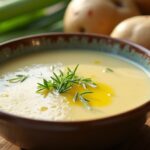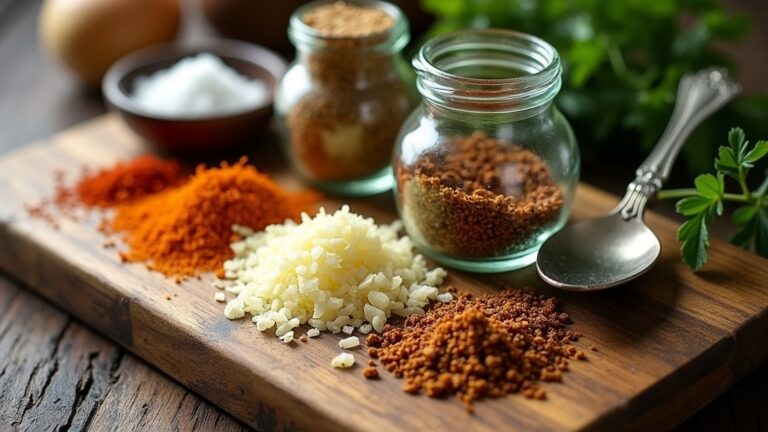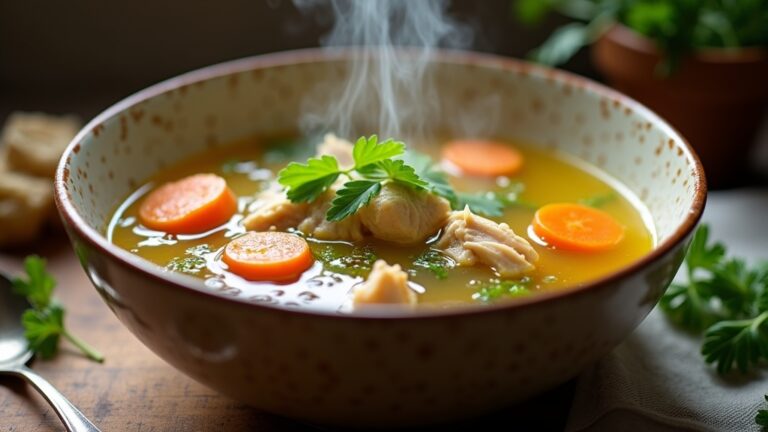Hot and Sour Soup Recipe
I love creating hot and sour soup, with its perfect mix of spice and tang. Start by gathering fresh ingredients like firm mushrooms, tofu, and crisp bamboo shoots. Prepare a flavorful broth with soy sauce, vinegar, and sesame oil, then add cubed tofu for creaminess. You can easily customize the heat and sourness to suit your taste. It’s a nutritious option that supports digestion and boosts the immune system. Want to know more about variations and serving ideas?
Contents
History
When you plunge into the history of hot and sour soup, you’ll discover a rich tapestry woven from centuries of culinary evolution. Originating in the heart of Chinese cuisine, this dish embodies the essence of balance, blending the fiery kick of white pepper with the tang of vinegar. It’s fascinating to see how regional variations reflect local ingredients and culinary traditions, each adding their unique flair. From humble beginnings as a peasant dish to its status on modern dining tables, hot and sour soup showcases the adaptability of Chinese cuisine. The interplay of textures—with silky tofu, crunchy mushrooms, and vibrant vegetables—invites innovation, inspiring chefs to experiment while respecting its storied past. Isn’t it amazing how food tells such compelling stories?
Recipe
Hot and Sour Soup is a classic dish in Chinese cuisine that beautifully balances savory, spicy, and tangy flavors. This flavorful soup is often made with a blend of ingredients like mushrooms, tofu, and bamboo shoots, all simmered in a rich broth that packs a punch. Perfect for chilly nights or as a starter for a larger meal, it’s a dish that warms the soul and tantalizes the taste buds.
The beauty of Hot and Sour Soup lies in its versatility; you can adjust the heat and sourness to suit your preferences. While traditionally made with white pepper and vinegar, you can experiment with different spices and acidic components to create a version that’s uniquely yours. This recipe will guide you through creating a delicious bowl of Hot and Sour Soup that is certain to impress friends and family alike.
Ingredients:
- 4 cups chicken or vegetable broth
- 1 cup shiitake mushrooms, sliced
- 1 cup firm tofu, cubed
- 1 cup bamboo shoots, sliced
- 1/2 cup shredded carrots
- 1/4 cup green onions, chopped
- 1/4 cup rice vinegar
- 2 tablespoons soy sauce
- 1 tablespoon cornstarch mixed with 2 tablespoons water
- 1 teaspoon white pepper
- 1 egg, beaten
- 1 tablespoon sesame oil
- Salt to taste
In a large pot, bring the chicken or vegetable broth to a simmer over medium heat. Add the sliced shiitake mushrooms, cubed tofu, bamboo shoots, and shredded carrots. Allow the mixture to simmer for about 5-7 minutes until the vegetables are tender. Stir in the rice vinegar, soy sauce, white pepper, and sesame oil. Gradually add the cornstarch mixture while stirring to thicken the soup. Once it reaches your desired consistency, slowly pour in the beaten egg while stirring gently to create egg ribbons. Finally, garnish with chopped green onions, and adjust the seasoning with salt if needed.
When cooking Hot and Sour Soup, feel free to customize the ingredients based on what you have on hand or your dietary preferences. For an extra kick, consider adding more white pepper or chili oil. If you prefer a vegetarian version, verify that the broth is vegetable-based and skip any meat components. This soup is best enjoyed fresh, but leftovers can be stored in the refrigerator for a day or two; just be aware that the tofu may absorb more broth, so you might need to add a splash of water or broth when reheating.
Cooking Steps
Let’s get cooking! I’ll guide you through each step to create the perfect hot and sour soup, starting with gathering fresh ingredients that’ll bring vibrant flavors to the dish. Once we’ve prepped the broth and added in those tasty tofu cubes and veggies, you’ll see how simple it is to adjust the seasoning to your liking.
Step 1. Gather Fresh Ingredients
To create a delicious hot and sour soup, I always start by gathering the freshest ingredients possible. I love visiting my local market, where vibrant vegetables and fragrant fresh herbs beckon. Look for firm mushrooms, crisp bamboo shoots, and bright green scallions to elevate the flavors. Don’t hesitate to explore ingredient substitutions; if you can’t find certain items, think creatively! For instance, if you’re out of white pepper, ground black pepper can work in a pinch, giving it a slightly different kick. Fresh herbs like cilantro or Thai basil can also add a unique twist to the traditional recipe. By selecting quality ingredients and being open to substitutions, I guarantee my soup is both innovative and satisfying.
Step 2. Prepare the Broth Mixture
With all those fresh ingredients ready to go, the next step is preparing the broth mixture that forms the heart of the hot and sour soup. I start by heating water in a pot, ensuring it reaches the perfect temperature; this is essential for ideal broth flavoring techniques. I add soy sauce, rice vinegar, and a touch of sesame oil, stirring gently to blend the flavors. The aroma begins to envelop my kitchen, hinting at the deliciousness to come. I keep an eye on the temperature, adjusting the heat to maintain a gentle simmer—too high, and I risk losing those delicate notes. Once I’m satisfied with the flavor, I’m ready to move on to the next exciting step!
Step 3. Add Tofu Cubes
Adding tofu cubes is an essential step that transforms the broth into a hearty, satisfying dish. I love using firm tofu for its ability to hold its shape and absorb the rich flavors of the soup. First, I cut the tofu into bite-sized cubes, ensuring even pieces for uniform cooking. This simple tofu preparation not only enhances the texture but also offers an array of tofu benefits, including a boost of protein and essential amino acids. As I gently stir the cubes into the simmering broth, I watch them soften, soaking up the hot and sour essence. The tofu adds a creamy contrast to the spicy and tangy notes, making each spoonful a delightful experience. It’s a game-changer, trust me!
Step 4. Incorporate Vegetables and Spices
As I plunge into the next steps of my hot and sour soup, the fragrant aroma of freshly chopped vegetables fills the kitchen. I love experimenting with different vegetable varieties to create a vibrant, colorful blend. I toss in some sliced shiitake mushrooms, julienned carrots, and vibrant bell peppers. Each adds a unique texture, complementing the silky tofu.
To elevate the flavors, I carefully choose my spice combinations. Here’s what I often use:
- Freshly grated ginger for warmth
- Crushed red pepper flakes for heat
- Ground white pepper for a subtle kick
- A splash of soy sauce for umami depth
With each ingredient, I can feel the soup transforming into something truly special. It’s a delicious journey in every spoonful!
Step 5. Adjust Seasoning to Taste
The vibrant medley of vegetables and spices sets the stage for the final masterpiece, but the true magic happens when you adjust the seasoning to taste. I start by tasting my soup, letting the flavors dance on my palate. If it leans too far into sour, a splash of soy sauce or a pinch of sugar can create a beautiful taste balance. Conversely, if the heat isn’t bold enough, I’ll add a dash of chili oil or fresh pepper. This is where flavor enhancement takes center stage; each adjustment transforms the dish into a personalized experience. Remember, it’s all about what excites your taste buds. So, don’t be shy—experiment until you achieve that perfect harmony of hot and sour!
Nutritional Guide
When I whip up a steaming bowl of hot and sour soup, I can’t help but appreciate its nutritional benefits. This delightful dish is a treasure trove of health, thanks to its vibrant ingredients. Let’s explore an ingredient analysis that showcases its goodness:
| Ingredient | Nutritional Benefit |
|---|---|
| Tofu | High in protein, low in calories |
| Mushrooms | Rich in antioxidants |
| Bamboo shoots | Supports digestion, low in fat |
| Vinegar | Aids in blood sugar control |
Each component contributes to a balanced meal, making my hot and sour soup not just a culinary adventure but also a nutritious choice. Embracing these elements, I feel empowered to nourish my body while enjoying every spoonful!
Final Thoughts
Reflecting on the nutritional benefits of hot and sour soup, I can’t help but feel grateful for how this dish blends flavors and health seamlessly. The versatility of this soup opens the door to endless innovations, making it a staple in my kitchen. Here are a few ideas to elevate your experience:
- Experiment with soup variations by adding ingredients like tofu, shrimp, or vegetables.
- Spice it up with additional chili paste or a splash of vinegar for extra zing.
- Serve with fresh herbs like cilantro or green onions for a revitalizing finish.
- Pair with rice or dumplings to create a satisfying meal.
With these serving suggestions, I hope you enjoy crafting your own version of this delightful soup!
Frequently Asked Questions
Can I Use Different Types of Mushrooms in the Soup?
I love experimenting with different mushroom varieties. Each type brings unique flavor profiles, enhancing the dish’s complexity. Whether it’s shiitake or oyster, your soup will burst with delightful, innovative tastes that’ll surprise your palate!
How Can I Make the Soup Vegetarian?
To make the soup vegetarian, I’d swap chicken broth for vegetable broth and use tofu for protein. I find flavor modifications, like adding miso or extra spices, elevate the dish while keeping it deliciously satisfying.
What Is the Best Way to Store Leftovers?
Oh, the tragic fate of leftover soup! For perfect leftover storage, I pour it into an airtight container, letting it chill before refrigeration. This way, my soup preservation skills shine, and I avoid culinary disasters!
Can I Freeze Hot and Sour Soup?
I often freeze soup, but keep in mind that the texture might change. For freezing tips, I recommend cooling it first, then using airtight containers. It’s a great way to enjoy soup later!
What Are Some Common Variations of This Soup?
When I explore variations, I’m reminded of how each region adds its flair. You’ll find spicy additions like chili oil or even unique mushrooms, showcasing the delicious regional differences that make this soup endlessly intriguing.
Conclusion
As I savored the last spoonful of my hot and sour soup, a wave of warmth enveloped me, leaving me craving just one more bite. Each slurp promised a perfect balance of heat and tang, and I couldn’t help but wonder—what would my next attempt taste like? Would I dare to experiment with new ingredients? The possibilities lingered tantalizingly in the air, urging me to return to the kitchen and release my creativity once more.











